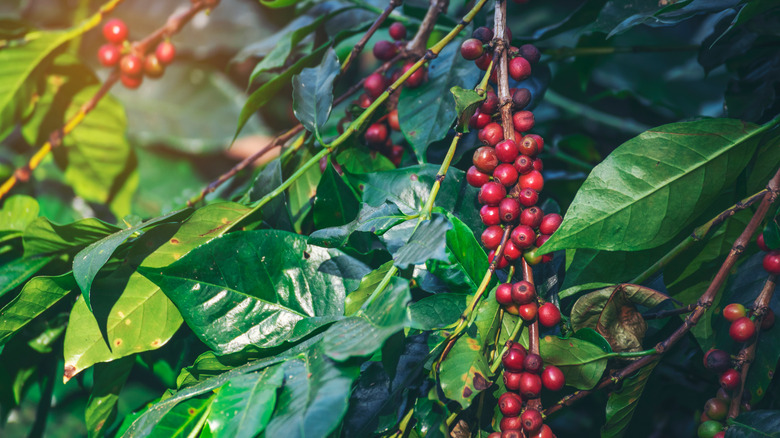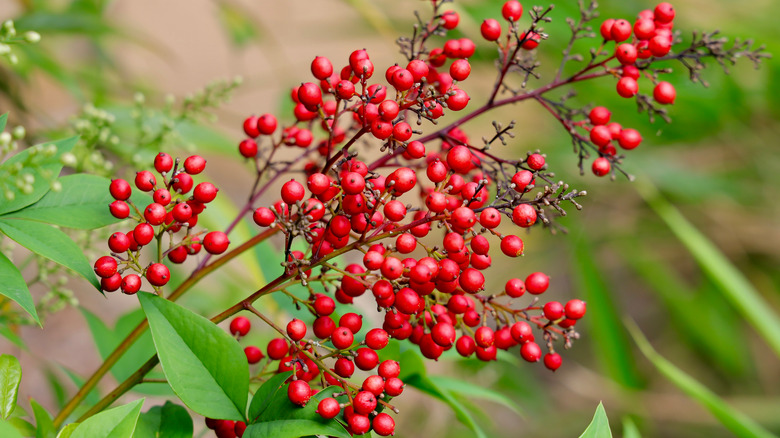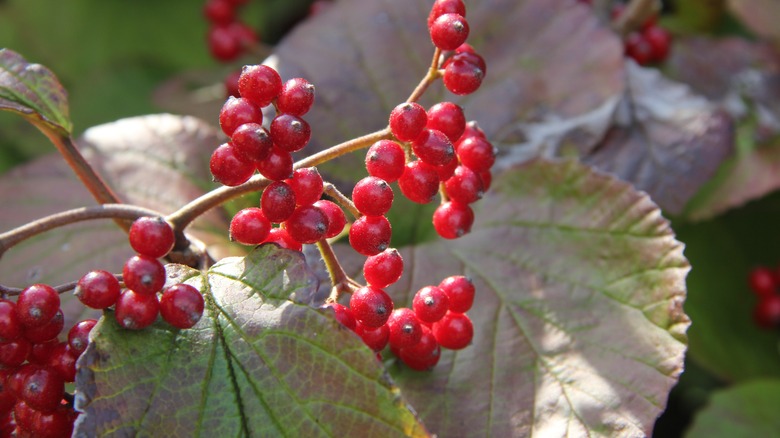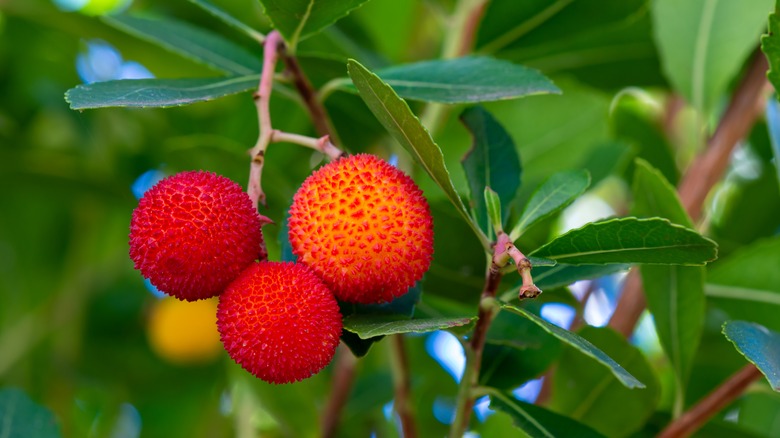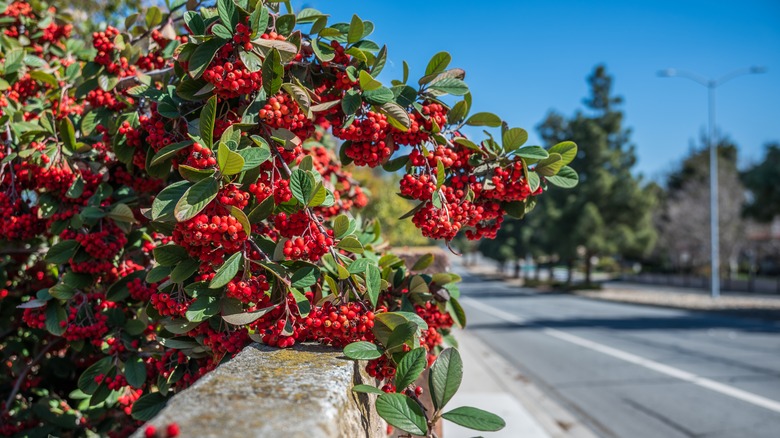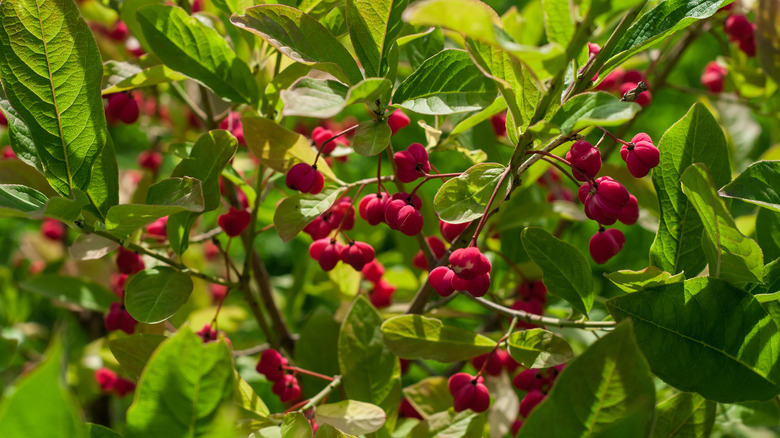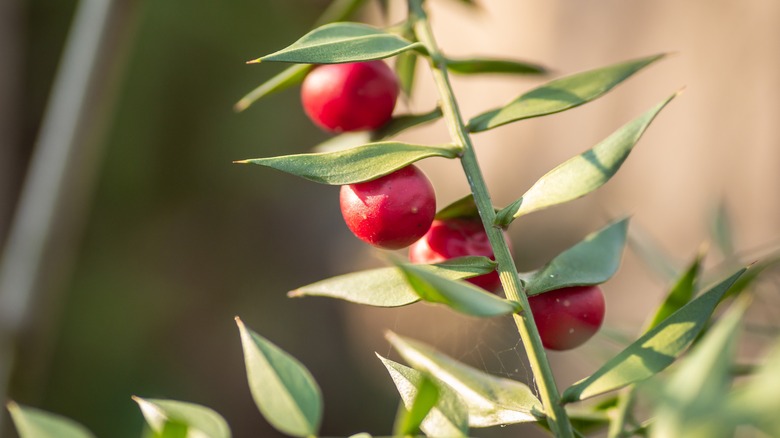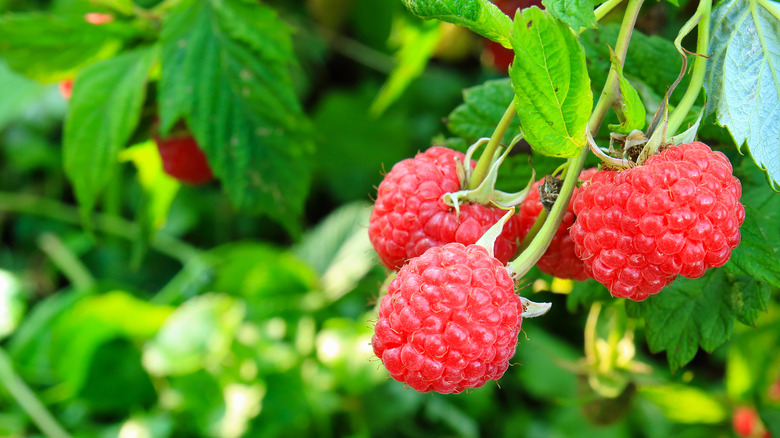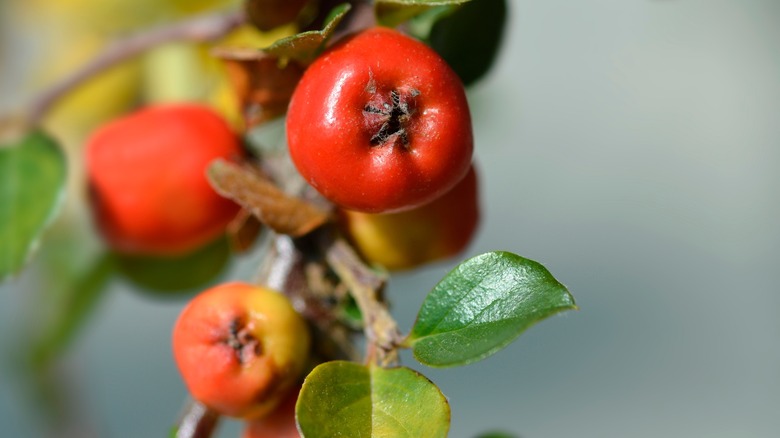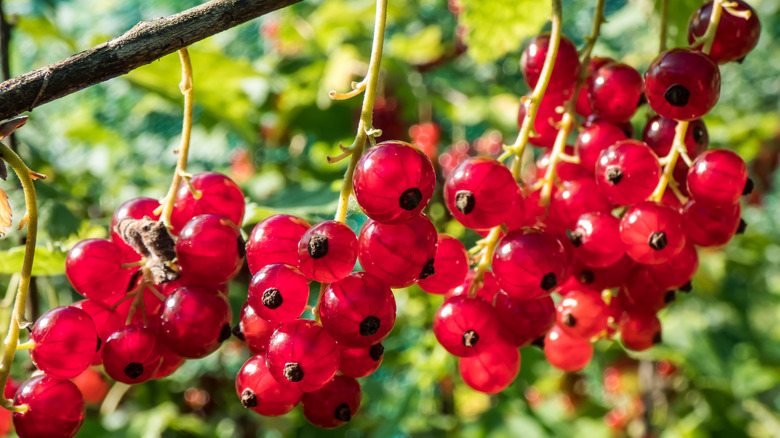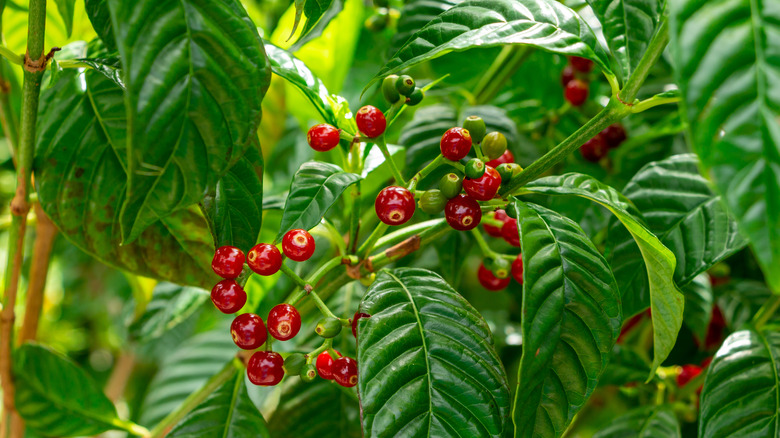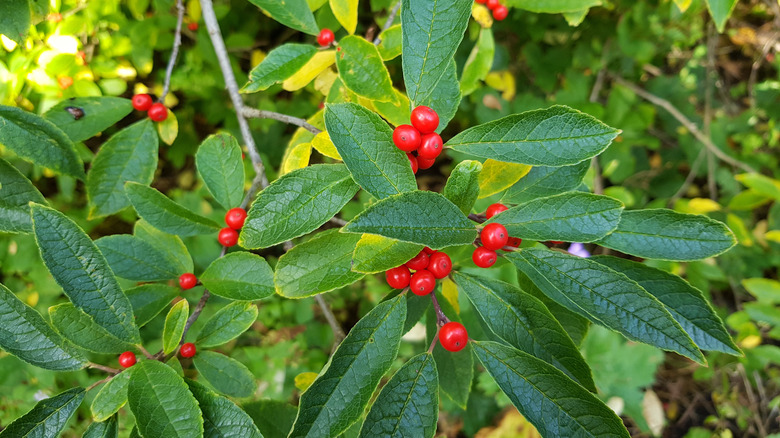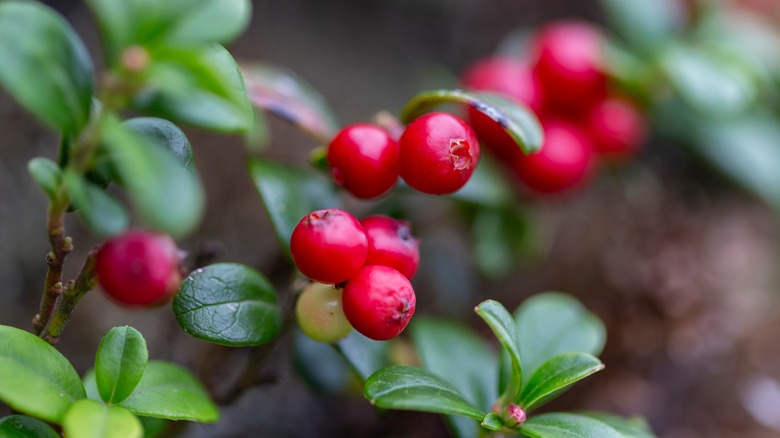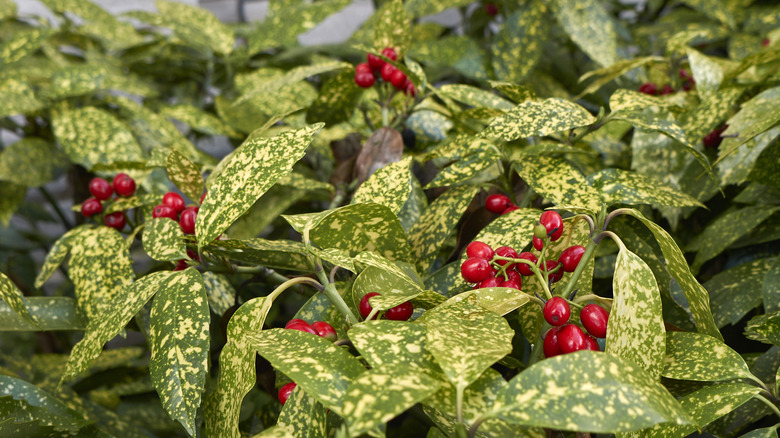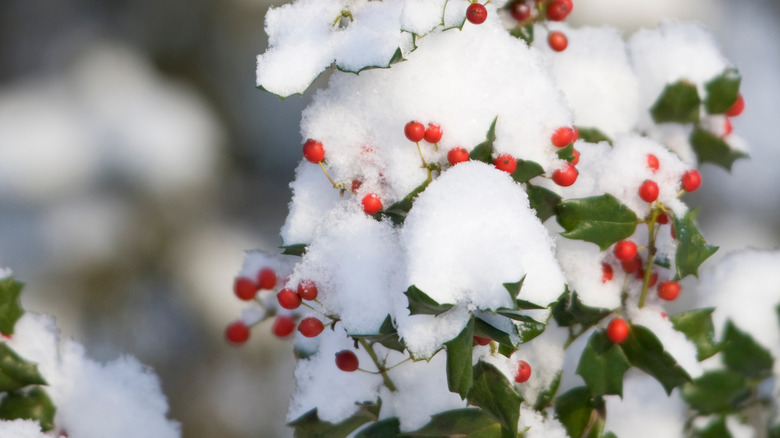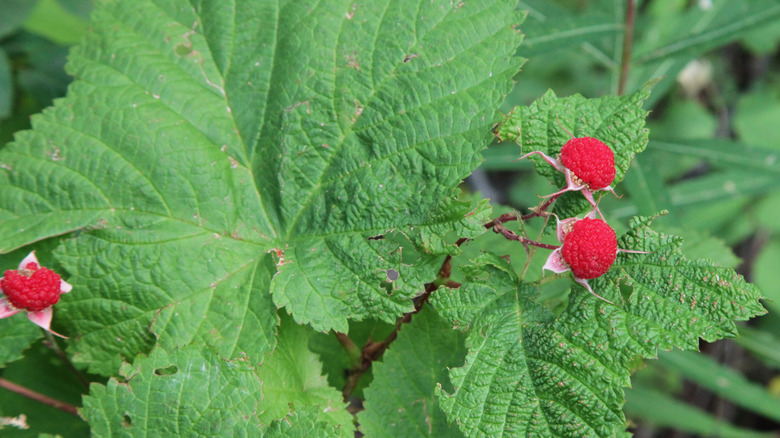15 Shrubs You Can Plant That Produce Pretty Red Berries
Some bright red color in the garden is one of the best ways to make your landscape even more eye-catching. This color, which is common in nature, stands out against the contrasting green foliage on shrubs, trees, and other plants. As listed by Proven Winners, rose bushes, carnations, coleus, and caladium are a staple in many lawns that take advantage of their bold color. Bushes that produce large or small red berries among their leaves and flowers hold a special place in the otherwise dim areas of the lawn, which receive some much-needed ornamental interest.
Typically, shrubs such as these keep berries on their stems throughout the fall and into the winter. So, when other plants are only showing bare branches and dying foliage, bushes like linden viburnum and heavenly bamboo continue to bring ornamental value to your garden, even if it's covered in snow. In this short collection, we've compiled 15 different shrubs that grow bright red berries, so you can consider each of them in your own garden depending on your soil, sunlight, and USDA hardiness zone.
1. Heavenly bamboo
Heavenly bamboo (Nandina domestica) is a broadleaf evergreen shrub that commonly grows taller than 6 feet in height. In the summer, the bush produces pink flowers that persist for a few weeks until the fall when they give way to bright red berries, as per Oregon State University. These berries stay red throughout the fall and winter for some colorful interest during the holiday season.
Bloom Season: Summer
USDA Growing Zone: 6 to 9
Growing Conditions: Full sun to partial shade
Soil Type: Moist and fertile
Size: Up to 6 feet tall
2. Linden viburnum
Linden viburnum (Viburnum dilatatum) is another four-season shrub that brings pretty red berries to your yard during the fall and winter, as said by The Morton Arboretum. A member of the honeysuckle family, this bush prefers plenty of direct sunlight and acidic soil. Keep in mind, linden viburnum can become 10 feet tall when cared for properly.
Bloom Season: Spring and summer
USDA Growing Zone: 5 to 7
Growing Conditions: Full sun to partial shade
Soil Type: Moist and well-draining
Size: More than 8 feet tall
3. Strawberry tree
The strawberry tree (Arbutus unedo) doesn't actually produce the sweet red fruit that we pick up from the grocery store. However, its fruit is still edible and frequently used to make jams, jelly, and brandy in some places. This fruit, which is described as bland by North Carolina State Extension, arrives in the early fall. Before then, the large shrub shows off fragrant white flowers.
Bloom Season: Fall and winter
USDA Growing Zone: 7 to 10
Growing Conditions: Full sun to partial shade
Soil Type: Well-draining
Size: 10 to 35 feet tall and 8 to 20 feet wide
4. Red chokeberry
The red chokeberry (Aronia arbutifolia) is commonly grown as an ornamental shrub in North America where it enjoys cool temperatures and fluctuating moisture, says Monrovia. Still, this bush is highly adaptable to a range of soils, moisture levels, and sunlight conditions. You can plant it almost anywhere in your garden. Keep in mind it thrives in wet areas near a pond or stream.
Bloom Season: Spring
USDA Growing Zone: 4 to 9
Growing Conditions: Full sun to partial shade
Soil Type: Adaptable to a wide range of types
Size: 6 to 8 feet tall and wide
5. Spindle tree
Spindle trees (Euonymus europaeus), which may also be referred to as cat trees, catwood, louseberry trees, and skewerwood, are a species of spreading deciduous shrubs that produce red and orange lobed berries in the fall. RHS notes that these shrubs are low-maintenance. All they need is some sunlight and well-draining soil.
Bloom Season: Spring
USDA Growing Zone: 4 to 7
Growing Conditions: Full sun to partial shade
Soil Type: Well-draining
Size: 20 feet tall and 16 feet wide
6. Butcher's broom
The butcher's broom shrub (Ruscus aculeatus) is also called knee holly because it frequently reaches knee height. This bush is characterized by round, red berries and glossy, green leaves, as per North Carolina State Extension. A member of the asparagus family, butcher's broom is tolerant of drought, poor soil, and full shade conditions.
Bloom Season: Spring
USDA Growing Zone: 7 to 9
Growing Conditions: Partial to full shade
Soil Type: Well-draining
Size: 18 to 36 inches tall and 24 to 48 inches wide
7. Raspberry bush
Raspberry bushes (Rubus idaeus) are well-known for their delicious berries that are often used to make jelly, jam, or simply eaten raw. Missouri Botanical Garden mentions that raspberries are somewhat difficult to maintain. They need rich and well-draining soil as well as lots of direct sunlight. When properly cared for, the bushes provide many tasty red berries and grow up to 9 feet tall.
Bloom Season: Spring
USDA Growing Zone: 4 to 8
Growing Conditions: Full sun
Soil Type: Well-drained, organically rich, and mildly acidic
Size: 3 to 9 feet tall and wide
8. Cotoneaster shrub
Cotoneaster shrubs (Cotoneaster apiculatus) are red berry-producing groundcover plants that spread about 6 feet wide. This low-growing shrub is known for its ability to grow well with other bushes such as roses, juniper, dogwood, and cranberry bushes, as told by Monrovia. Cotoneaster shrubs are commonly planted for seasonal interest in the garden due to their bright berries and color-changing leaves.
Bloom Season: Spring
USDA Growing Zone: 4 to 7
Growing Conditions: Full sun to partial shade
Soil Type: Well-draining
Size: 3 feet tall and 6 feet wide
9. Red currant bush
The red currant bush (Ribes rubrum) is native to Western Europe where it is provided with cool temperatures and moist, acidic soil. It is regularly planted near streams and ponds that keep its soil wet, according to Balkep. This bush with semi-translucent red berries attracts pollinators such as bees, so it can play an important role in pollinator gardens.
Bloom Season: Spring
USDA Growing Zone: 4 to 8
Growing Conditions: Full sun to partial shade
Soil Type: Moist
Size: 4 feet tall
10. Wild coffee
Wild coffee (Psychotria nervosa) is a warm-weather plant that shows off ovate red berries after it finishes blooming in the summer. The bush is native to Florida, but it can be found growing in many warm areas across the United States. The University of Florida points out that the fruit of the plant resembles coffee beans, and though the berries are edible, they are not a substitute for real coffee.
Bloom Season: Spring and summer
USDA Growing Zone: 10 and 11
Growing Conditions: Partial to full shade
Soil Type: Well-draining
Size: 10 feet tall and 8 feet wide
11. American winterberry
American winterberry bushes (Ilex verticillata) produce many red berries after their bloom season. These small fruits cover the branches of the shrub throughout the fall and winter, so when the leaves of the plant die and fall to the ground, you are left with a naked, multi-stemmed shrub that is full of bright red color, says Proven Winners.
Bloom Season: Late spring
USDA Growing Zone: 3 to 9
Growing Conditions: Full sun to partial shade
Soil Type: Wet soil
Size: 72 to 96 inches tall and wide
12. Lingonberry bushes
Lingonberry bushes (Vaccinium vitis-idaea) are a species of broadleaf evergreen shrubs that are native to the temperate parts of the Northern Hemisphere, according to Missouri Botanical Garden. They grow quite small, frequently only to about 1 foot tall. This makes them a good option for use as an edible, berry-producing, ground cover plant.
Bloom Season: Spring
USDA Growing Zone: 3 to 7
Growing Conditions: Full sun to partial shade
Soil Type: Well-drained peaty loam
Size: 1 to 3 feet wide and 3 to 12 inches tall
13. Spotted laurel
Spotted laurel (Aucuba japonica) is a gorgeous and dense shrub that has many different varieties with unique leaves. Its tidy growth habit allows this bush to be used as hedging or even grown in a container. There are endless ways to plant it as long as you provide your spotted laurel with shade and well-draining soil, as told by Oregon State University.
Bloom Season: Spring
USDA Growing Zone: 6 to 9
Growing Conditions: Partial to full shade
Soil Type: Organic, moist, and well-draining
Size: 6 to 10 feet tall
14. Castle blue hollies
Castle blue hollies (Ilex x meserveae), also called Meserveae holly or Meserve holly, are bushy plants that boast glossy, pointed leaves and round, red berries. North Carolina State Extension states that this holly bush is well-known for its ability to grow in very cold conditions. With good care, the castle blue holly plant will grow quickly up to 6 feet tall.
Bloom Season: Spring
USDA Growing Zone: 3 to 7
Growing Conditions: Full sun to partial shade
Soil Type: Acidic and well-draining
Size: 3 to 6 feet tall and 8 to 15 feet wide
15. Thimbleberry bushes
Thimbleberry bushes (Rubus parviflorus) commonly grow on roadsides in the western part of the United States and Canada. They are adaptable plants that tolerate flooding, cold weather, and little attention, as per Missouri Botanical Garden. In the garden, thimbleberry bushes are most often planted as an informal hedge. However, they also work well in bird gardens and edible gardens.
Bloom Season: Spring to summer
USDA Growing Zone: 3 to 10
Growing Conditions: Full sun to partial shade
Soil Type: Well-drained, rich, and somewhat acidic
Size: 4 to 8 feet tall and wide
